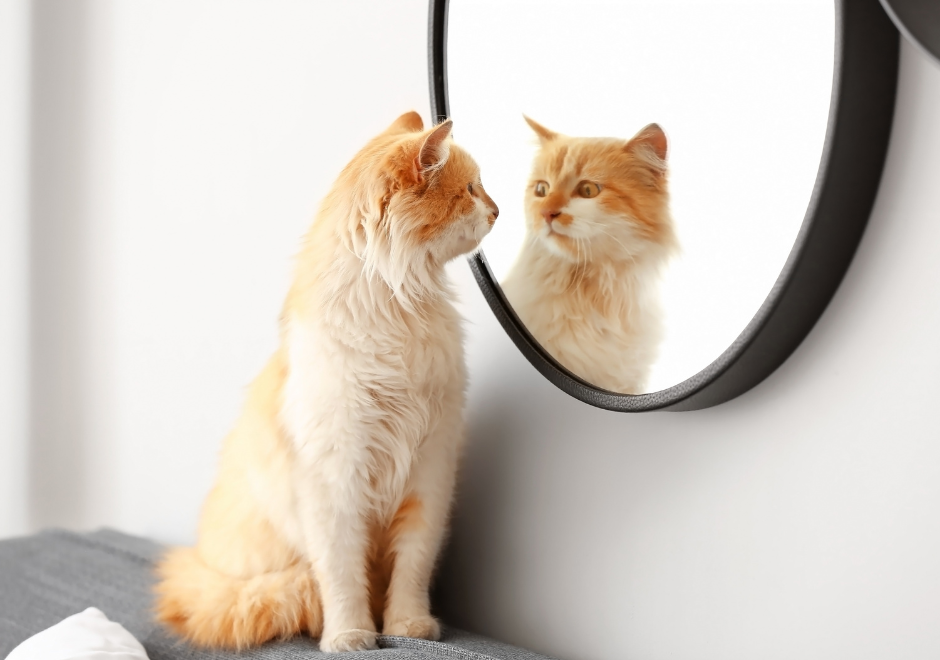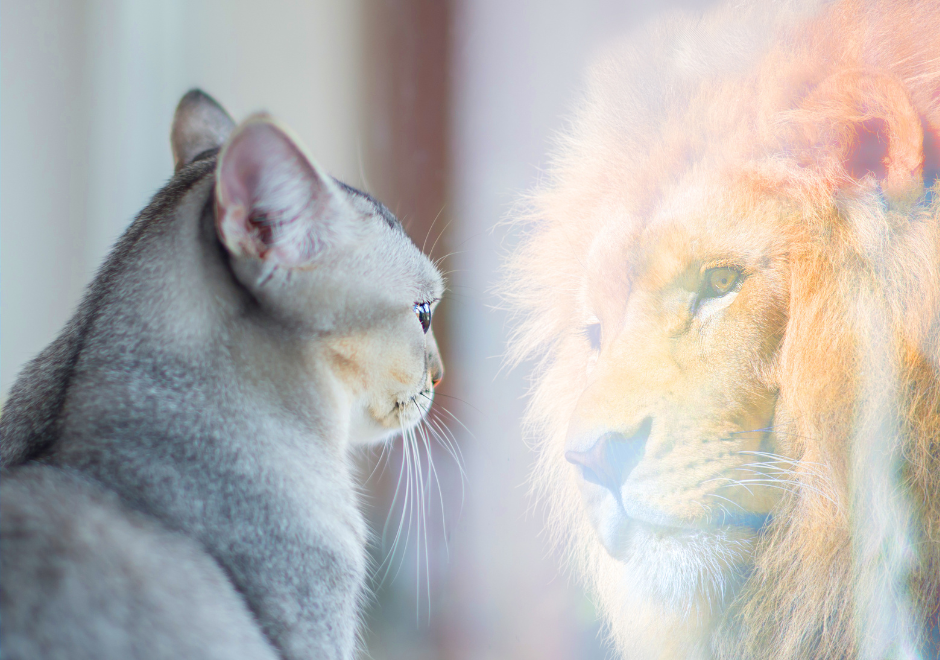This article may contain one or more independently chosen Amazon affiliate links. See full disclosure.
We’ve all seen videos of a cat freaking out at its reflection in a mirror or seeming to admire his feline perfection, gazing at himself in loving awe. But does your cat truly recognize itself in the mirror? Let’s go beyond the cute videos and explore the science of how cats react to mirrors.
Do Other Animals Besides Humans Recognize Themselves in Mirrors?
The first question we should ask is whether other animals recognize their own reflection. This is one of the most interesting questions in animal psychology and leads to some quite entertaining films.

It does seem that chimpanzees, orangutans, dolphins, and maybe elephants seem to know they are looking at themselves in the mirror, at least after some experience. But what about cats? Does your cat recognize its reflection in the mirror?
Cats Seem to Behave as If they Recognize Their Reflection
Many people are convinced that their cat definitely recognizes its own reflection and the hundreds of cute YouTube videos could certainly convince you that it’s true.
The cat reacts to the reflection, and may even seem to be admiring it or reacting to it in ways that indicate self-recognition.
But such informal observation doesn’t tell us much. In those videos I mentioned, the owners usually think the cat is posing and are aware that the reflection is itself. Many people who comment on the videos believe it, as well.

You must realize that even human children do not initially recognize their own reflection in the mirror. It takes about 18 months before they begin to do so.
If a cat could recognize his reflection, this might indicate that he is at least as intelligent and self-aware as an 18-month-old human. Of course, this only holds true if we believe that recognizing your reflection indicates itelligence or self-awareness.
The Rouge Test (Mirror Self-Recognition Test)
If you really wanted to test your cat, you would use the aptly named rouge test. A more technical name for this test is MSR test or Mirror Self-Recognition Test.
This is how animal psychologists figured out that chimpanzees, orangutans, elephants, dolphins, and even magpies recognize their own mirror images. Dolphins, it turns out, were a bit harder to prove than you might think.

The rouge test is quite simple in application if complex in control. Scientists paint a mark somewhere on an animal’s body that the animal cannot normally see then check to see whether the animal reacts to this mark when looking in a mirror.
The mark is traditionally made in rouge makeup, hence the name. After painting a red mark on a chimpanzee’s forehead, the chimpanzee will likely react by reaching up and touching the red mark, as if to say, how did that get there?
Hands or No Hands: The Problem with Interpretation
As previously stated, dolphins were a bit harder to check. The problem is that when a chimp reaches up and touches a mark, it is obvious that they are reacting to the mark and recognize the reflection as their own.
But dolphins don’t have any hands and cannot touch the marks made on their body so the behaviors they demonstrate, which seem to be reactions to marks, such as turning their bodies to inspect the area, might be misinterpreted.
Nevertheless, after some painstaking 2001 research by Reiss and Marino at the New York Aquarium, it seems fairly certain that dolphins, too, pass the test. But do cats? Alas, no. Neither do dogs and monkeys.
Yes, cats looking in mirrors for the first time do tend to approach the reflection. They may even touch their nose to the nose of the reflection and react to the movement, etc. They respond much the same way a child does who does not yet recognize a reflection as him or herself.
Only a child will eventually figure out that they are looking at themselves. Cats, on the other hand, do not and have never indicated reliably that they can learn to recognize their reflection.
Kittens will react quite hilariously to mirrors at first. Again, there are many YouTube videos to corroborate this. However, if they are afraid or alarmed by the ‘other cat’ they quickly grow bored and will stop reacting strongly.
Many people take this as evidence that they are no longer concerned because they know it is them in the mirror. This is not evidence, but simply one of many possible interpretations of the behavior.
Although we can never know what a cat is thinking, it is just as likely that they grow bored of the image and don’t think much about it at all.
What Are Cats Reacting to in the Mirror?
But how can this be? Well, cats do not rely strongly on vision like we humans. The cat in the mirror may look like a cat, but there is no scent and no sound. Without smell or some other sense signal, a cat may not see the image as important.
Cats are strongly triggered by movement. It may be the movement in the mirror that caught its attention in the first place.
But when no smell or sound is forthcoming, cats eventually learn to ignore the mirror. You may notice that the television keeps your cat’s interest longer than a mirror. There is movement and sound. A program about birds might be quite entertaining to a cat, at least for a short time.
This does not mean that cats are dumb or “not self-aware.” The notion that recognizing your reflection is an indicator of self-awareness is quite controversial.
Just because a chimpanzee can recognize itself in the mirror does not mean it is capable of more abstract levels of self-awareness or that it ruminates on its own mental state. To prove that will be much more difficult.
And, while cats may not be among the animals who can recognize their own reflection, cats have many other amazing abilities to make up for this minor inability.
Cats see better than humans, have amazing noses, super hearing, and unrivaled agility. They also have a lot more going on upstairs than previously believed. To read more about a cat’s mental abilities, see What’s Going On In Your Cat’s Head at Scientific American.
